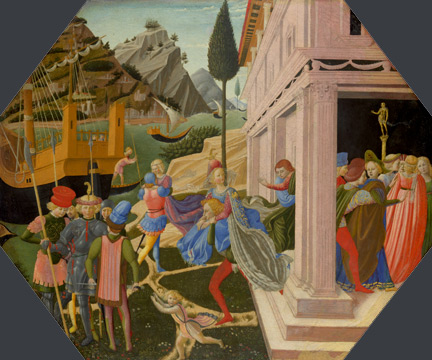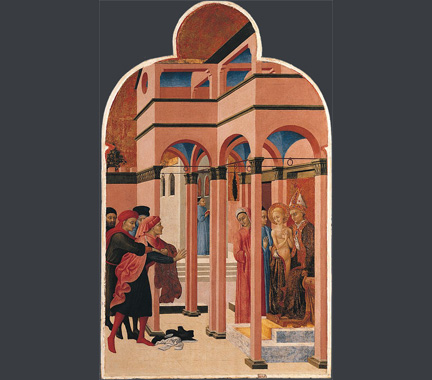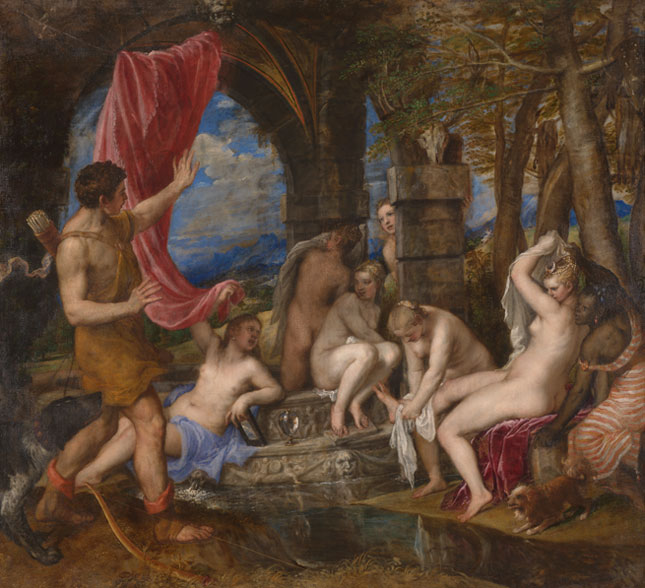Author: Amanda Lillie
1. Exploring the roles played by architecture in Italian Renaissance painting
Why did artists incorporate architecture in their pictures? What does it mean for a painting to be architectural? The aim of this exhibition is to explore these questions by examining the roles architecture played within Italian paintings from the Late Middle Ages until the High Renaissance. Buildings in paintings have too often been viewed as background or as space fillers which play a passive or at best supporting role, propping up the figures that carry the main message of the picture. By looking afresh at buildings within paintings, treating them as active protagonists, it becomes clear that they performed a series of crucial roles.1
Buildings had an important aesthetic function. They decorated and enlivened pictures with their geometric forms, their elegant arches and columns, their colours and materials, and the fine details of their friezes or capitals. In this sense architecture was used to provide a repertoire of ornamental motifs. But architectural aesthetics also worked on a deeper level within paintings, as the particular qualities of scale, structure, proportion, mass, and the whole languages of Gothic or Classical architecture were available to be selected, absorbed and reinterpreted within a painting. A picture could achieve an architectural sort of beauty. Thus, in Lorenzo Costa's drawing for a lost or unexecuted fresco of 'Christ in the House of Simon the Pharisee' (fig. 1) the ornamental details of capitals, bases, sculpted reliefs and niches are barely sketched in (figs. 2 and 3).
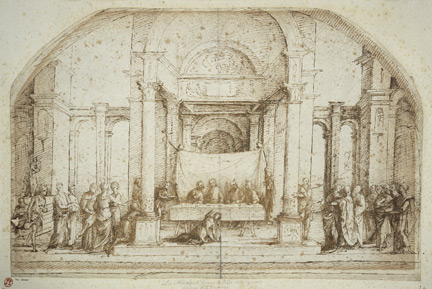
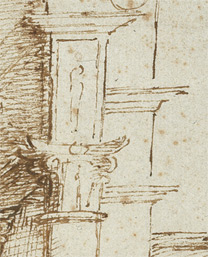
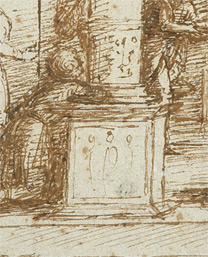
The buildings are not treated as motifs or decorative forms, but rather provide an overarching architecture which soars above the figures and unifies the image with its elegant proportions, its symmetry, the layering of its buildings and the creation of airy, inter-flowing spaces. This is a structural and compositional type of beauty, rather than one of detail and surface decoration.
The notion of architectural beauty is taken in another direction in 'The Abduction of Helen’ attributed to Zanobi Strozzi, where the architecture of the palace-like building becomes a metaphor for beauty (fig. 4). The colour pink was probably chosen for the façade because it conveys the prettiness of Helen rather than being a serious attempt to imitate a real building material such as brick or Verona marble. Helen’s beauty is architecturally expounded in the loveliness of the building, coloured like a face in pink, with black and white touches, with the fine bone structure of the classical orders applied to it, and the delicate ornament of foliate garlands and cherubs swinging along its frieze. The architecture thus amplifies the meaning. Dangerous beauty is at the heart of this story, as it is for every story about Helen of Troy.
Architecture also structured compositions, providing well-proportioned designs for the whole image, and strong, unified inner frameworks that directed the viewer's attention, placed particular emphases, and created episodes or micro-environments for the narrative. In Sassetta's 'Saint Francis renounces his Earthly Father' (fig. 5) the naked Saint Francis seeking refuge in the embrace of the Bishop is framed in the arch on the right, clearly separated from his angry father left outside the church to the far left.
This is the moment when the son leaves the security of home, family and inheritance to espouse religion. The painting describes this separation in architectural terms. The architecture not only frames and enhances the figures and their gestures, but its arches also structure the narrative, giving it direction and pace – a left to right momentum and a rhythm pivoted around two actions with a central hiatus. Above all, it visually intensifies the emotional pull of the subject matter, the empty centre ground marking the impassable spiritual and psychological distance between father and son.
Thus, architecture within pictures could be specifically designed to tell a visual story, articulating the plot, deepening viewers’ understanding of the moral or emotional content of the narrative, and helping them to engage imaginatively with the events. Almost every aspect of architectural design could be brought to bear on the narrative, from the control and balance established through meticulously measured, symmetrical compositions to strident colours and opulent building materials. Viewers’ emotional responses could be subtly or powerfully calibrated through architecture.
Titian used the structures of the stone basin and the vaulted arches to build feeling in his ‘Diana and Actaeon’ (fig. 6). It is partly because we expect architecture to be strong, stable and perpendicular that the tilt of the basin is disturbing. It destabilises the whole picture.
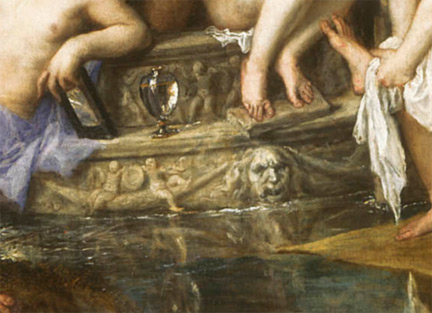
Instead of providing a protective rim to contain the water or a central island plinth for statues or people to perch on, the two-tier circular sculpted plinth is lurching into the water. And where we would expect the head of a merry putto between the swags, Titian has substituted the head of a wild, elderly gorgon or witch, who is the only figure in the picture to stare directly at the spectator (fig. 7).
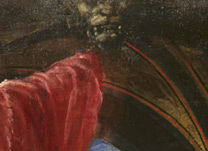
The arched stone canopy looks at first like a massive version of a gazebo transposed to woodland, but its disconnected and incomplete parts imply it was never an independent structure, and is a ruined fragment of a bigger building. The head on the keystone – a lion perhaps – is worryingly crooked with a strange grimace like a statue about to come to life. The polychromy of the groined vault under the arch strikes a discordant note as the remains of a bright interior overtaken by the darker forces of nature (fig. 8). The stones of the outer arch begin strongly above and behind Actaeon, but then blur and connect in an unreal way to the pier with the deer skull on the right, while the bottom of the left-hand pier is non-existent.
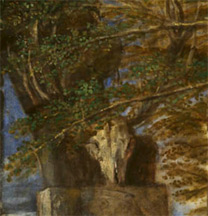
This structural confusion adds to our sense of unease. The deer’s skull (fig. 9) is the clearest sign that the architecture is there to warn us of what is to come, of Actaeon’s fate when Diana turns him into a stag to be hunted down by his own dogs. Instead of the skull forming part of an Ancient Roman frieze of bucrania (ox skulls), an elegant repeated pattern which carried sacrificial significance but no longer smacked of the kill, here the lone skull is of an individually imagined animal, only recently dead. It may be attached to a pier and is the same colour brown, but it seems to be bone. Altogether, Titian uses his power as a painter to create architectural ‘ornaments’ that are materially ambivalent, assuming the strange condition of stone that seems half alive. Architecture’s role in ‘Diana and Actaeon’ is to build a sense of foreboding.
All these roles are tightly interconnected and can be further subsumed within the category of visual rhetoric – the art of persuading the viewer – for architecture was used by painters as a powerful tool to move and influence the spectator. Although ancient, Byzantine and medieval art was certainly concerned with viewers’ responses, different types of engagement with the spectator and worshipper were emerging in the Renaissance period. Artists addressed and even incorporated their audience or congregations into the work in more direct, gestural ways, and employed architecture to this end. In Domenico Veneziano’s Carnesecchi tabernacle (fig. 10) and Costa and Maineri's altarpiece (fig. 11), the Christ Child stands as far forward as possible while still being held by his mother, perched on the promontory of her knee, from where he can directly look at and bless the faithful.
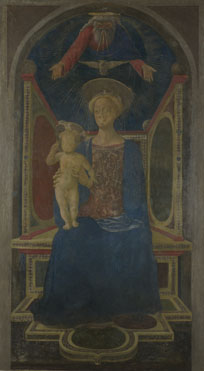
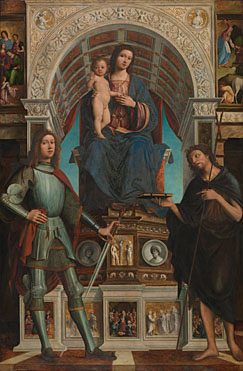
This combined sense of an infant Christ who is protected, while at the same time reaching out to the world, is reinforced by Domenico Veneziano’s throne and Costa and Manieri’s arch. Both architectural forms are designed to enclose and protect their precious contents, yet they are also open-ended and address the public with their emphatic structures. Likewise, the ruined triumphal arches of Botticelli’s and Peruzzi’s Adoration of the Kings (figs. 12 and 13) seize our attention and magnify their message in the way the ancients had intended their triumphal arches to function: like headlines or billboards in built form.
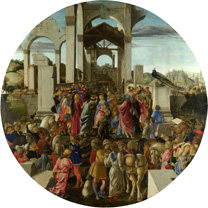
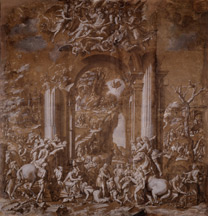
2. Architecture in painting: a symbiosis
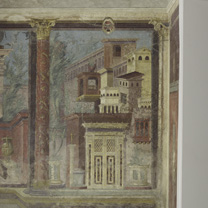
Although painting and architecture are usually considered to be two different arts or separate disciplines, artists and architects have always been inspired by each other and have shared ideas and practices. Architectural painting was not a Renaissance invention. Buildings have been part of the essential repertoire of artists in every era. Architectural representations of different types exist from ancient Egypt and Mesopotamia to Rome and Byzantium, from ground plans carved into stone slabs to trompe l’oeil wall paintings (fig. 14).2 In late medieval and Renaissance Italy, Pompeii and Herculaneum still lay buried, and artists knew very little of ancient painting, but Roman buildings survived, as well as sculptures and medals incorporating architectural imagery. Furthermore, throughout the Middle Ages artists used architectural inventions in their icons, frescoes, manuscripts and sculptures, and Italian Renaissance artists employed designs and details from every type of medieval artefact (fig. 15).
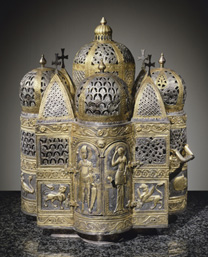
An important reason behind the close inter-relationship between painting and architecture in the Renaissance was that the training of artists and architects led to a more integrated practice in the arts. There was no specific educational programme or apprenticeship for architects. Brunelleschi was apprenticed as a goldsmith, Alberti studied law at university and went on to be a cleric, scholar and writer, Giuliano da Sangallo began as a carpenter, Bramante (fig. 16) was trained as a painter, Raphael was first and foremost a painter, and Michelangelo began as a painter and sculptor before designing buildings later in his career.
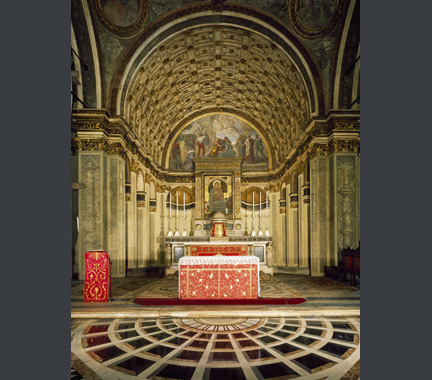
Despite a lack of formal training in architecture, skills were transferred between the visual arts. Painting and architecture were closely interwoven and nourished each other. It was not a straightforward case of the large scale, three-dimensional, inhabited medium of architecture being precisely and respectfully imitated in the smaller, two-dimensional, fictional medium of painting, as though the power flowed in one direction, the smaller being a pale imitation of the larger. Nor was architecture translated into painting as though it had been first expressed in a different language, for embryonic architecture already existed in the visual imagination of painters, sculptors, carpenters, goldsmiths, printmakers and other artists. An architectural imagination is not the prerogative of architects. On the contrary, the architectural creations of Renaissance painters were treated as inventions to be manipulated and disseminated by builders, architects and patrons. Although tracing the architectural legacy of these imagined buildings lies beyond the scope of this publication, paintings like these fed the architectural imagination and visual culture of the period, often foreshadowing what was built by a decade or even a generation. Pictures were storehouses of architectural ideas.
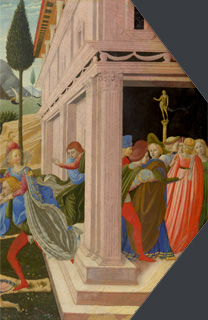
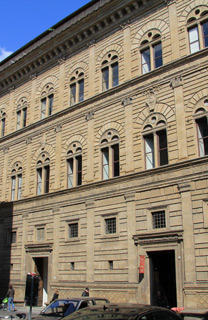
One example of the innovative exploration of architectural design in painting is the building in 'The Abduction of Helen’ (fig. 17). This fusion of temple and palace from which Paris abducts Helen of Troy is a remarkably advanced design that adopts the classical orders and other antique style details from Florentine buildings and reconfigures them.3
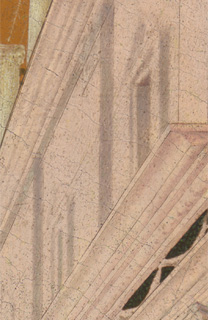
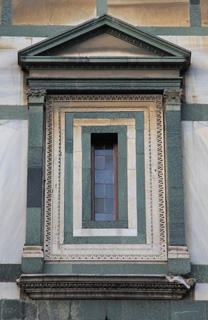
Features on the façade such as the Corinthian pilasters, the tabernacle windows and the frieze with swags and putti were imitated from a whole range of local sources such as the Florentine Baptistery (fig. 20), Brunelleschi’s San Lorenzo, the Palazzo Rucellai (fig. 18), and the fictive architecture of Ghiberti and Masaccio (figs. 21 and 22).
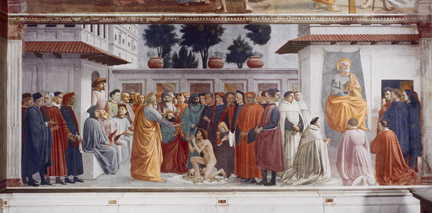
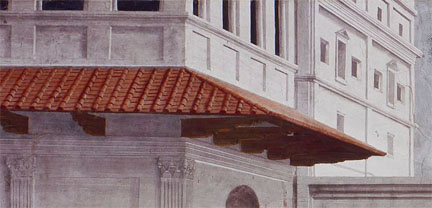
Yet what Zanobi Strozzi produced is more than a mere amalgamation of his sources, for he achieved a unified new design – a prototype for a grand domestic building. Significantly, this type of palace was not built before the early 16th century, 50 years after the visual concept was being developed in painting and relief sculpture.
To cite this essay we suggest using
Amanda Lillie, 'Introduction', published online 2014 in 'Building the Picture: Architecture in Italian Renaissance Painting', The National Gallery, London, http://www.nationalgallery.org.uk/research/research-resources/exhibition-catalogues/building-the-picture/introduction

